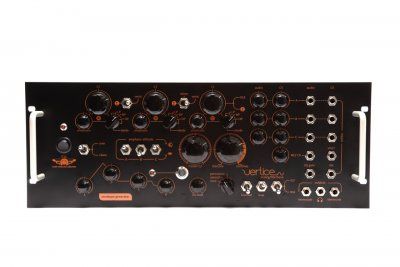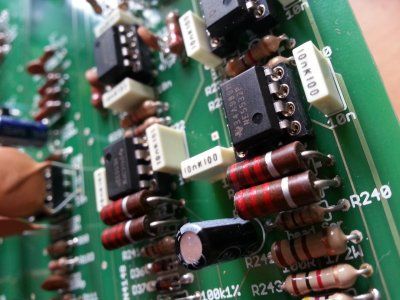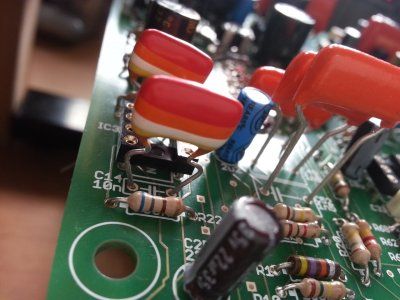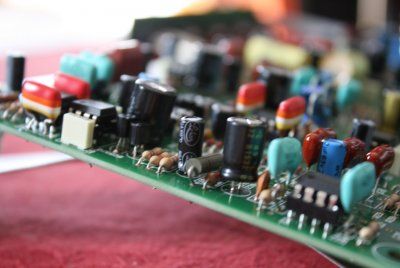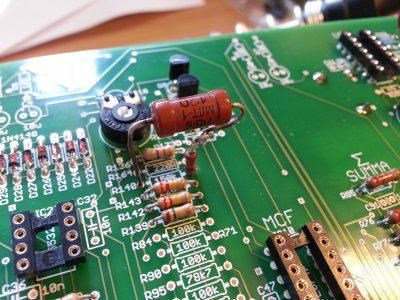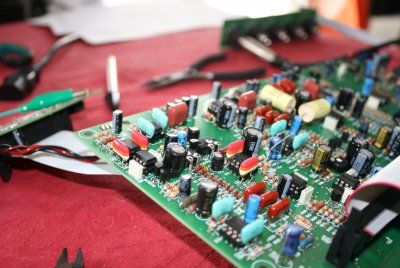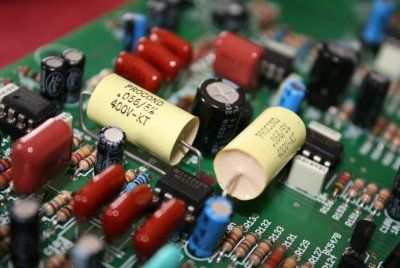Email von Stefano Bersanetti:
Stefano Bersanetti - Audio Circuital Designer
Euterpe Synthesizers
Via Madonna del Popolo, 30
12040 Sanfrè CN - Italy
T(+39) 3395928083
www.euterpesynth.com
In brief, Vertice is:
- a
Filter. Is composed by 3 filterboards based on the Sallen-Key idea reinterpreted by Nyle Steiner. I started from the original 1974 schematics and worked on bass response (more than the original) and usability (idem).
This is the only filter I know having
two different resonance paths for each filter. One is the original one, called “diode”, very smooth progression, classical sounding when in the middle of the race, really unstable and impossible to tame if fully clockwise. The second one, called “transistor" is my design, simply to try to be complementary to the original. Less dynamic, a bit stepped behavior in the middle of the race and hysterically screaming when fully clockwise. I like to say that my resonance path “scream like a dying pig”, if you can imagine the sound of this so innocent picture.

With a bit of reso you can easily equalize, when in tracking modality, obtaining sparkling high freq.
This is a true signal feedback so more reso = more level = more presence (more dB).
- an
Amplifier. Vertice contains 3 Baxandall preamplifiers, very quiet noise and more than 17dB gain plus two very powerful VCA’s on the final stages. Those VCAs are designed around two sons of the famous dbx2150, heart of many SSL and dbx professional products. Very musical oriented and, when overloaded, incredibly metallic and silicon suffering sounding.
- a
Distortion module. Overloading things with Vertice is easy and sometimes really satisfying. You have a dedicated overload function before the A filter and there are at least two way to easy destroy signal in the final stage, as said just before.
- a
Compressor. Using this two VCA stages together with the EG section you can also compress, expand, destroy and pulverize. It’s incredible the reachable dynamics and the musical possibilities, from simple tracking to let your whole base to be processed and maybe compressed by a side chain key signal (the EG, which is the responsible of the compression movements, react very easily with audio signals, and, of course, standard CV gate signals, so it’s easy to use to drive the VCA in order to compress).
Since the EG can also invert its output phase you can also
expand.
Since I always try to give to who believe in me something more than other factory producers you will find that this two features, compression and expansion, must be used very carefully to obtain something classical, because a consistent part of the EG Level pot is dedicated to total destruction of signals passing through a very massive metallic distortion process.
Vertice philosophy is like Napoleon invading Russia: the borders are so large that it’s difficult to choose were to go, in the beginning. But with a couple of weeks of practice customers say they use it blindfold, bypassing also the "all black in a dark place problem”, ‘cause of knobs dimensions mainly, but also ‘cause of the sufficiently straight design that don’t capture so much your attention, useful when in live sessions where you have to control tons of parameters at the same time.
- a
Summing processor. Vertice apply a true analog through hole sum that will leave your signals tight together but never confused among them. Obviously distortion is every time behind the corner (which in my opinion for a creative machine like Vertice is an advantage) but simply without too much input gain it will disappear like snow in the desert. Vertice is all about moderate yourself a bit, because if you let yourself go it will literally blow up your home.
Moderating yourself will indeed let you discover the equalizing character of Vertice. If, for example, you split a drum loop into 3 signals, it can be done simply using a Mult module, even passive (Vertice will take care of re-gain the part of level that the passive circuitry lose during the splitting process), you have the same loop into 3 different cables. So, why not to plug them into Vertice, serial mode, and use the first filter for the bass drum, the second for the snare and the third for the unfiltered signal (but maybe with some sparkling high freq caused by a bit of Emphasis)? The third will “glue” the first and the second one, plus giving power and deep presence. Now you have a pot for the low freq and one for the middle. Maybe is not so creative but I can promise you will be satisfied by this sort of technical manipulation.
- a
weird complete synthesis system. You need two cables. One is the output, one of the 4 (two front and two rear) present. And the other is to connect “something rear” with A, B or C filter input. You will pleasantly surprised about that function. In short the (low) noise of the, for example, not working A filter will reflow into itself (the patch I immagine here is Rear A out into front A input). The results are sometimes spectacular since everything you move, Master Cutoff, various emphasis, audio levels, EG looping freq, change the pitch and also the waveform, creating really impacting, harsh and experimental tones. And you can also do rear B into front A, in serie with rear A into front B and eventually one of the two rear main outs into the front C filter, all in one patch. Possibilities are many and often
really creative.
Then you have to consider that the EG can easily be triggered by a 0/5V standard gate signal but also by a common audio signal. In the first case you have a real synth, where A into A is the weird VCO and B and C filter are the filters and can be driven, exactly as the VCAs, by the EG. Long story short, if you have a CV emitting keyboard you have the possibility to control the VCFs and the VCAs hitting the key, and if you have also the “pitch” value you can drive Vertice also in the V/oct way (but not with the precisions of a real VCO however. It’s a filter

).
In the case of the audio triggering instead, if you use a drum loop you will obtain what I get in the video I link before.


